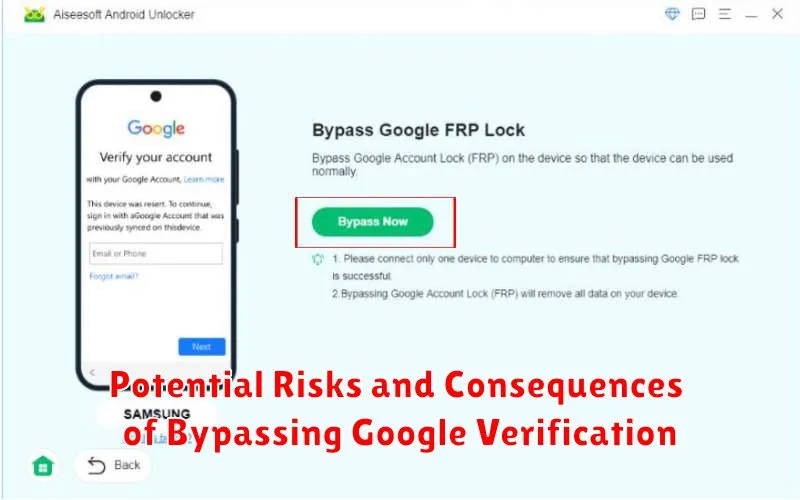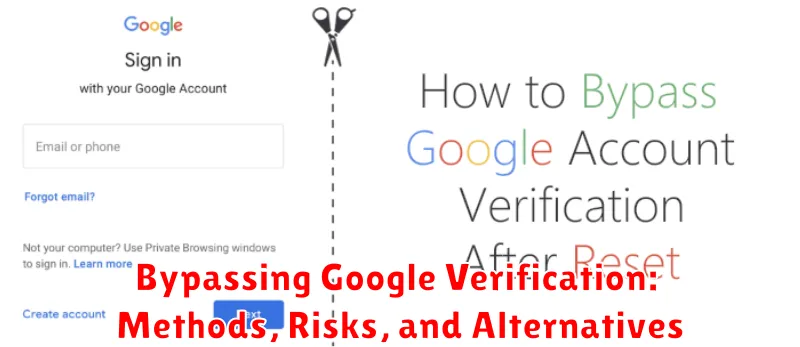Unlocking a Google-locked device can seem like a daunting task. Whether you’ve forgotten your Google account credentials after a factory reset or purchased a second-hand device with a pre-existing lock, bypassing Google verification, often referred to as Factory Reset Protection (FRP) lock, can present a significant challenge. This article explores various methods to bypass Google verification, outlining the risks and benefits associated with each method, alongside safer and more legitimate alternatives. Understanding the nuances of Google verification bypass, its potential repercussions, and the available options is crucial for anyone facing this issue.
While the prospect of bypassing Google’s security measures might be tempting, it’s essential to proceed with caution. Bypassing Google verification involves inherent risks, including potential data loss, security vulnerabilities, and even bricking your device. Before attempting any bypass methods, it’s imperative to explore legitimate alternatives. This article provides a comprehensive overview of these alternatives, ranging from account recovery options to contacting the previous owner or seeking professional assistance. Weighing the risks against the need to bypass Google verification is the first step towards making an informed decision. Learn more about how to navigate this complex issue responsibly and effectively.
What is Google Verification and Why Does It Exist?
Google Verification, also known as Factory Reset Protection (FRP), is a security feature implemented by Google for Android devices. It’s designed to prevent unauthorized access to a device after a factory reset.
When you perform a factory reset on your Android device, FRP kicks in, requiring you to sign in with the Google account previously associated with the device. This prevents thieves from simply wiping a stolen phone and using it themselves.
The primary purpose of Google Verification is to protect your personal data in the event of loss or theft. It acts as a deterrent and a safeguard against unauthorized access, making it much harder for someone to use your device and potentially access sensitive information like emails, contacts, and photos.
Common Situations Requiring Google Verification Bypass
Several situations can lead users to seek ways to bypass Google’s verification process. While understanding these situations is important, it’s crucial to remember that bypassing verification often carries risks and should be approached with caution. Factory resets are a common trigger. After a reset, the device requests the original Google account credentials, which can be problematic if the user has forgotten them.
Second-hand device purchases present another scenario. If the previous owner didn’t properly remove their account, the new owner might face a verification lock. Similarly, software glitches or updates can sometimes corrupt system files, leading to an unexpected verification request even when the user knows their credentials. In rare cases, a user might legitimately own a device but lack access to their Google account due to lost or compromised credentials, motivating them to seek bypass methods.
Methods to Bypass Google Verification on Android Devices
Attempting to bypass Google verification involves exploiting vulnerabilities or utilizing unofficial tools. These methods are often device and Android version specific, and their effectiveness can vary significantly.
Note: The following information is for educational purposes only. Bypassing Google verification can have serious security implications and may void your device’s warranty. We strongly discourage using these methods for illegal activities.
Common Techniques (May Not Work on All Devices)
- Exploiting setup wizard vulnerabilities: Some older Android versions had vulnerabilities within the setup wizard that could be exploited to gain access to the device without completing the verification process. These are often patched in newer updates.
- Using third-party tools or software: Some tools claim to bypass Google verification, but their effectiveness is questionable and may carry security risks, such as malware or data theft.
- Resetting through recovery mode: While factory resetting through recovery mode usually doesn’t bypass verification, some specific methods might involve manipulating the recovery process. These are often complex and device-specific.
Potential Risks and Consequences of Bypassing Google Verification

Bypassing Google Verification, while seemingly convenient, carries significant risks. Data loss is a primary concern. Attempting to bypass verification can sometimes result in a factory reset, wiping all data from the device. Additionally, bypassing verification may void any warranty associated with the device, leaving you with limited options for repairs or support.
Security vulnerabilities are another major risk. Bypassing security measures can leave your device susceptible to malware and unauthorized access. This can compromise your personal information, including financial details and online accounts. Furthermore, some bypass methods might require installing third-party software from untrusted sources, increasing the risk of malware infection.
Bricking the device is a less common but severe consequence. Incorrectly executing bypass procedures can render your device completely unusable. This is especially true for more complex methods that involve modifying system files.
Legal and Ethical Considerations
Bypassing Google Verification involves circumventing a security feature implemented to protect user data and device ownership. Therefore, the legality and ethics of bypassing this protection are complex and depend heavily on the context.
Legally, bypassing Google Verification on a device you own, if done for legitimate reasons such as forgotten credentials, is generally acceptable. However, bypassing Google Verification on a device you do not own, even if purchased second-hand without a factory reset, can be considered illegal in certain jurisdictions. This can be construed as unauthorized access to data and potentially a violation of property rights.
Ethically, bypassing Google Verification should only be performed on devices you own and with the understanding of the potential security risks. Attempting to bypass this protection on a device you do not own is ethically questionable, even if technically possible. This action could potentially expose the previous owner’s data and violate their privacy.
Alternatives to Bypassing Google Verification: Recommended Practices

Instead of resorting to potentially risky bypass methods, consider these recommended practices:
1. Recover Your Google Account Credentials
The most straightforward solution is to recover your Google account. Visit the Google Account Recovery page and follow the steps. You’ll likely need to provide information like the associated email address, phone number, or security questions.
2. Contact the Previous Owner
If you purchased a used device, contact the previous owner. They can remove their account from the device remotely. This is the most ethical and efficient approach.
3. Contact the Device Manufacturer or Carrier
For new devices or if contacting the previous owner isn’t feasible, reach out to the device manufacturer or your mobile carrier. They may offer support options for Google account verification issues.
Troubleshooting Common Issues During the Bypass Process
Attempting to bypass Google verification can sometimes lead to unforeseen issues. This section addresses common problems and offers potential solutions.
FRP Bypass Tool Malfunctions
Some FRP bypass tools might not function correctly due to incompatibility with specific Android versions or device models. Ensure the chosen tool supports your device and Android version. Consider trying an alternative tool if one fails.
Internet Connectivity Problems
A stable internet connection is crucial for most bypass methods. Verify your Wi-Fi or mobile data connection is active and stable. Try restarting your router or switching to a different network.
Device Stuck in Bootloop
If your device gets stuck in a bootloop (continuously restarting) after attempting a bypass, try a factory reset if possible. This can sometimes resolve underlying software conflicts. Be aware that this will erase all data on the device.
Incorrectly Entered Information
Double-check any information entered during the bypass process, such as Google account credentials or codes. Even minor typos can prevent successful bypass.

